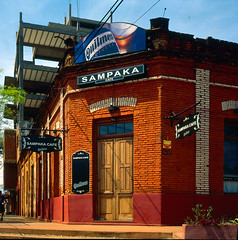Remember that very “English” black-and-white print I made of a café in Hove?
This supersaturated colour medium-format slide film shot of another corner café, taken in Argentina, is a nice counterpoint to it; even the angles of the shadows are similar. As the photographer says, the stock it was taken with came out of the freezer.
Today, some film traditionalists are stockpiling specialist emulsions on ice as they go out of production. Chilling film is supposed to slow down its chemical decay and preserve its colour response. Technically this must be true; exactly how effective it is I have no idea. I’m not stashing crates of discontinued varieties of Fujifilm in a basement chest freezer, but I don’t take any chances with the stuff I use for everyday work, especially the colour—even though the film I use most of the time is very “laid back“.
This morning, I was shuffling unused rolls in my fridge and it made me think of fishing enormous sheets of photographic paper out of minus 70°C back in the early 90s (with gloves on), when the chemical reagents I used in a typical week cost more than my salary. Ah, happy days—NOT. Then, I was probably one of the last generation of biomedical lab monkeys to sequence DNA the old-fashioned way (just as, today, I’m stuck taking photos the old-fashioned way). DNA sequencing is done by robots these days—not that I’ve been in a so-called “wet” lab for years. Maybe people still do it by hand to check they’ve cloned or mutated the right thing in the right place or in undergraduate practicals.
(Funnily enough, I only met Frederick Sanger, the man who invented DNA sequencing, because a chemistry professor visiting from the US insisted I introduce him to the guy. I wouldn’t have had the nerve to approach him otherwise. I didn’t need it. Sanger is nice and modest and, physically, completely unremarkable. He is also the only human being alive to have won two Nobel prizes.)



Recent Comments